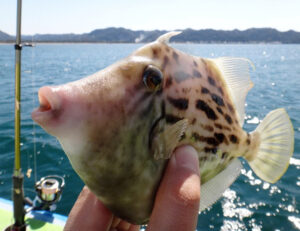Squid fishing from a boat; Tip-run Eging
Squid is one of the favorite species for anglers. We target it in various ways of fishing and we enjoy the taste of it after fishing. Presently, the most popular way of catching it is what we call Eging (pronunciation like ‘egg-ing’), or squid lure fishing (general idea was shown in this article). The word Eging is from Egi (its pronunciation is similar to ‘egg-ii’), meaning the squid lure in Japanese.
Originally, Egi squid lure was popularly used in shore fishing, but it extended to offshore fishing now. If you fish offshore, then you have to face the deeper range. Here we have relatively newer methods in the course of lure fishing style for squids.
In this article, I will explain this offshore Eging called the Tip-run Eging. As I start from some information of the target species, I will introduce this Tip-run Eging.
Species
The main target of this fishing is Aori-ika (Bigfin reef squid, Sepioteuthis lessoniana.) It is living in the west coasts of pacific, indian ocean, middle east and in mediterranean sea.
It is also becoming a popular species in the Adriatic sea and the southern mediterranean sea.
As it prefers warm water, bigfin reef squid is popular in the western of south western Japan. But it is expanding to the north year by year. Currently, it is said that they are living along some coasts of the Hokkaido island. And we can say this species is now available
It lays eggs on the seaweeds near the coast from spring to summer, and they spawn in about one month. These baby squids feed actively and they grow very quickly to become 300 to 1,000 grams by the end of autumn. Naturally, this timing, from summer to autumn, is the best timing for shore fishing. Their favorable temperature is from 13 to 25 degrees. They become less active if the water temperature becomes close to 30 degrees.
They grow up to about 33 cm, of the trunk length, on average. But the record size of this squid in Japan, caught by angling, is over 50 cm.
If you are interested, you can view the video of catching the over 50 squid with Eging, from this YouTube link.
They are carnivorous and feed on various kinds of bait creatures. They eat jack mackerels, sardines, half lined cardinal, wrasses, goby, etc. Additionally, they eat crustaceans such as shrimps and mantis shrimp, though it seems they do not like crabs.
Eging the basic
Let me start with showing the basics of Eging. This is considered to be one kind of lure fishing in Japan, using the special lures for squid, called Egi.
Using this lure, anglers cast away and repeat jerking and reeling. The important part is in the falling of it in the water. It is said that this falling moment is the moment most likely a squid catches the lure. So the posture, speed and angle, during the falling, is very important.
The reason why it involves the strong jerking is that such a strong and quick movement is attracting the attention of a squid. To raise the attraction, some Egi lures have the design to add special effects such as darting and rattles.
Tip-run Eging
The basic Eging is done from the shore, and naturally their target depths are not so deep.
As is normally the case in angling, when an angler wants more fish or bigger fish, one of his or her options is to go deeper, in sea fishing.
It was what happened in Bigfin reef squid fishing in Japan. Angers headed offshore to catch their targets.
And it requires something different from the approach of shore Eging.
The start is the weight of the lure. It needs to be heavier, to make sure it lands on the bottom. This is not a big problem as you make one Egi lure with a heavier sinker.
With this extended lead head, the lures are 30 - 40 grams. And the position of the eye is different from that of normal Egi, for the angle of the line is more vertical than Egi for shore fishing.
In shore Eging, the bite or the touch of squid can be detected in the movement of the slacked line as well as the direct pull of the squid.
However, offshore, it is not possible, because the most part of the line is in the water, and anglers cannot see it to detect the bite. It is extremely difficult to know the bite, while the lure is falling naturally.
Angler's solution to this problem is to have a softer tip to detect the bite.
You need to give the minimum tension on the line, enough to detect the bite, as you are allowing the lure to fall (or actually staying) as naturally as possible. The specially designed special rod has the nice softness to hold the line softly.
With using this, you can detect the bite by the movement of the tip of the rod, or by the ‘tip-run.’ You focus on the tip while your Egi is falling, and the tip can tell you the bite.
This is the concept of the Tip-run Eging.
For the tackle you need a special Tip-run style rod and the special Egi lure.
The special thing about the rod is in the tip. It has the soft tip, often painted by the brighter color to raise the visibility.
You can look at the below videos, of the whole process of this Tip-run Eging.
You can see the tip when a squid is on in this moment of the video above from this link.
Fishing techniques are always changing. As long as anglers have the will to get more fish or bigger fish, there will be new methods improved.
Actually, this Tip-run allows anglers to target this Aori-ika, or Bigfin reef squid during night. This requires another technique and, in the future, it can be a step for the next invention.

